I woke up at 2:00 after 4.5 hours of sleep. I got up for about a half hour as I wasn’t falling right back to sleep. Once I lay back down, I slept until about 6:30. I had the most vivid dreams at some point during the night—not exactly sure if they were during the first hours of sleep or the latter hours.
Two of the dreams where about having gone back to the U.S. to attend a local STC meeting, and then realizing when I was back there, that I was supposed to be in China. I panicked wondering how I was going to be able to get a flight back the same or next day, and how incredibly expensive it was going to be.
The first time I dreamed it, it was so real that when I woke up I was so overwhelmingly relieved to already be in China. When I feel asleep again, and it started happening again, I actually said to myself, in the dream, “I know this seems so real, but I know I’m just dreaming. Wake up.”
I have been able to do this in the past with dreams that are so scary that I want to wake up from them. However, it did not work this time, so once again, when I woke up I was incredibly relieved that it was a dream. Weird.
One of the first things I did this morning was to spray, a very small amount fortunately, some hand sanitizer into my mouth instead of the Zicam I had with me for my cold.
Breakfast this morning was a complimentary buffet, as it will be each morning we’re here at the Swissotel in Beijing. I overate, and I overate bad things—way too many carbs. It was all good, though, and I hope to make better choices the next two mornings. We’ll see.
There were two incredibly hot men in the area of my table, both Swedes or somewhere of that origin, so not dark-haired and hairy like I’m usually attracted to. They both had on jeans that made me think of the lyrics from that country song Badonkadonk: “Lawd have mercy how’d she even get those britches on?”
I had good mornings from Paula and Kathy, and then Linda stopped by my table to tell me that people are having a hard time accessing livejournal.com (for our group blog), which stressed me out. Nothing could be worse than having recommended a blog provider, and then it not work. Especially since the blog provider Linda wanted to use was blogger.com and she said she had no problem posting to her personal blog on it.
I may have to break down and pay $14 to access the Internet in this hotel, and see if I have any problems posting. Grrrrr.
We had an “In-Country Briefing” this morning from 9:00-11:00, in which we were filled in on what to expect throughout our entire trip. Alexia took a couple of pictures, since she was our blogger for today.
Shawn introduced “Richard” who will be the guide for the guests in their touring while we’re in meetings. We covered how to say hello and good morning.
The rest of the briefings covered the following topics. I’ve put the details behind a cut. Click on them if you’re interested in reading them.
Geographic Map of China
- The shape of China looks like a rooster. Beijing is located at the lower part of its neck, and Shanghai is located by the mouth of the Yangtze River that empties into East China Sea.
- China is the third largest country, only after Russia and Canada; the nation covers about 3.7 million square miles, and two-thirds of its land is not cultivatable.
- East China is lower than West China; Yellow River is the mother river; Yangtze is the longest river and divides China into the north and the south.
Administrative Map of China
- China’s population is 1.3 billion, with 16 million newborns annually, and 7.5% of the population is over 65 years old.
- In China, the Han nationality is the majority (92% of the nation’s total population), and the nation has 55 other ethnic minority groups (no discrimination). [Insert eyebrow raise here. Uh, Tibet is in that area.]
- China has 23 provinces, 5 autonomous regions (where most of the ethnic minorities live), 4 municipal cities (Beijing, Shanghai, Chongqing, and Tientsin [check the spelling of those last two]), and 2 special administrative regions (Hong Kong and Macau [check the spelling of those last two]); they are all at the same provincial level.
- Guilin, our second city stop, is close to Viet Nam and the southeast Asian countries. Shanghai, with about 17 million people, is the economic powerhouse of China. When he noted that Taiwan is still considered one of the provinces, most people laughed. Being the ignorant geography and history person that I am, I didn’t get it.
History
Next was a quick history level that I didn’t capture very well. Here are some highlight notes:
- We saw a timeline that started with the birth of Confucius in 561BC and ended in 1978 with “Opening up policy.” Confucianism is more of a philosophy than a religion. The 5 tenants of Confucianism: benevolence, righteousness, propriety, intelligence, and loyalty. [Check these, particularly propriety.]
- 221 BC: Qin Dynasty, the first feudal dynasty, began. This is the official date of the building of the Great Wall.
- 618 AD: The Tang Dynasty began, and this was one of the most prosperous dynasties of them all.
- 1840: The Opium Wars (There were actually two opium wars: one between China and England, and another between China and the French-British allied forces.)
- 1911: Qing Dynasty ended. In the west this dynasty is also known as the Manchurian Dynasty. The end came about by the overthrowing of the dynasty in a revolution lead by Dr. Senya-Song [Check the spelling of this.], and the republics were born.
- 1921: The birth of the Communist Party.
- 1949: Communist Party “victory,” and Beijing was once again made the capital.
- 1966 The Cultural Revolution began.
- 1978: The Opening Up Policy began.
Aside: Italian explorer Marco Polo came to China in the 1279 time frame, in service to Kublai Khan. There is a recent popular book called 1421, by an Australian author, that posits that America was actually discovered by a Chinese explorer 71 years before Columbus. It’s a very controversial book, but very interesting.
There are two flags in China: one with a big star and four stars in a semi-circle to the right of it, which is the national flag, and the Sickle and Hammer flag, which is the Flag of CPC (Communist Party of China).
Major issues that China is still tackling: population and the inequity between eastern (the rich) and western (the poor) China. In China there are still over 300 million people who live below the poverty line.
The population restriction is relaxing slowly, but there is still the one birth rule. That’s births, not children, so if you have twins, “you’re lucky.” If the first child is a girl, four years later, you can have another try. If the second child is a girl, “sorry.”
Traveling in China
- Meals and eating in China: Round-table service mainly, let us know your special requirements ASAP. With every meal, you get two glasses of water, soda, or beer. There are no age-restricting laws about alcoholeven Konrad, our 16-year-old guest of a delegate can have beer if he wants it (and his mother lets him, of course).
- Post and communication:
- Postage for post cards to U.S. is $0.5.
- Shipping service is available.
- Calling home from the hotel room is a very convenient, but also the most expensive way. Using pre-paid phone cards would be charged only $0.12 each time for the service. Access numbers are…
- Electricity is 220V in China and converters are available in all hotels.
- Public toilets have been improved, but not as cheerful as the ones in the hotels or the fancy restaurants. Public toilets do not provide toilet paper;take your own. In our hour-by-hour itineraries, we have noted where there are “western” bathrooms, as opposed to Chinese bathrooms in the places we’ll be visiting. As often as we could, we have made western restrooms available.
- Smoking is not forbidden in many public areas, but anti-smoking campaign is getting stronger. Offering a cigarette to someone in China is still seen as a friendly gesture.
- China covers four time zones, but Beijing time is the official time throughout the country! Punctuality is highly appreciated.
- Tap water is not potable. We will provide you with bottled water on the bus. Water served in all restaurants is safe. You receive two free bottles a day in your room.
- “Yuan” is the typical unit for RMB. 1 Yuan equals $0.12. Credit cards and traveler’s checks are accepted in hotels and government shops, so use them whenever possible.
- China is a very safe country, but we do need to be careful of pickpockets. Passports should be kept in the hotel safe deposit till the departure day. Also, write down the serial numbers of your traveler’s checks.
- There is no restriction on picture-taking at the scenic spots. Ask for permission when taking pictures of other people.
- Hotels we stay in are all five-star by international standards; business centers and gyms are available. Please check the price list before you ask for a service.
Chinese Language
- Written language is standardized all over the country.
- We have 40,000 pictographic square characters in total, of which 10,000 are in current use and 3,000 in very common use.
- Romanized spelling system is called Pinyin.
- Mandarin is the official language, and about 150 dialects are used in different parts of the country.
- The same word, spelled the same way, can mean up to four different things, depending on the four toneslevel, ending up, starting down and going back up, and ending down. For example: the word “ma” means: mother (level), linen or numb (up), horse (down and back up), and to swear (down).
Jenny asked about when we translate documents into two different types of Chinese. What’s that about. Shawng explained that that’s the difference between ancient Chinese (characters) and Simplified Chinese (characters), which is what is in use today.
After this briefing, some of the delegates helped Linda dole out the many gifts brought by everyone. We put them in separate bags in order to facilitate presenting them to the various groups with whom we’ll be meeting over the next 10 days or so. I, “Mr. Organized” himself, forgot to pack my gifts.
At 11:30, our group left for an afternoon of shopping and sightseeing. On the way to our first stop, Richard, our local tour guide for Beijing:
pointed out various venues from the recent 2008 Olympics.
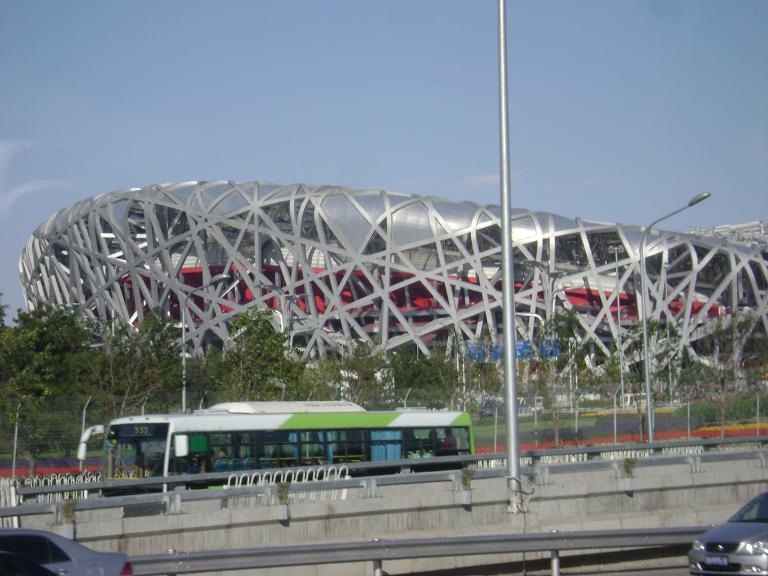
Here’s a shot of some of the housing used for the athletes. You can still see the Aussie flag left in one of the windows in the upper right-hand corner of the photo.
Upon arrival at the Dayi Friendship Store & Restaurant, which is government run:
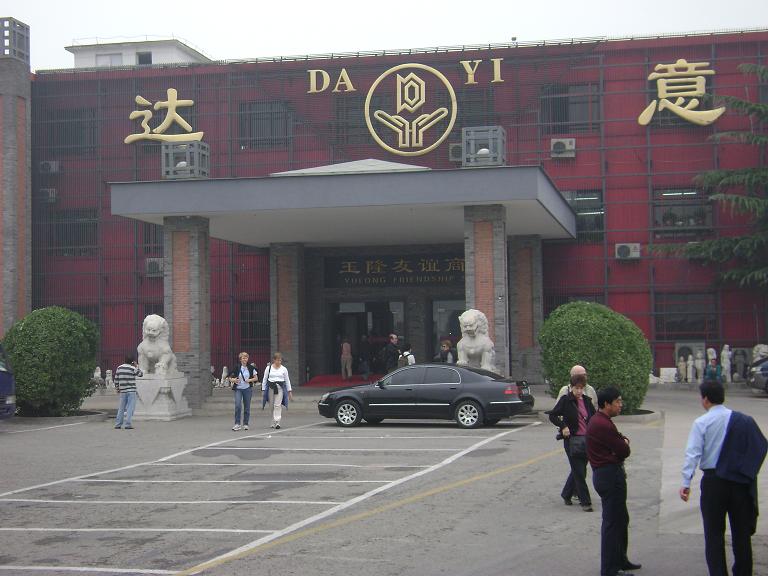
We first toured the Cloisonne Factory inside,
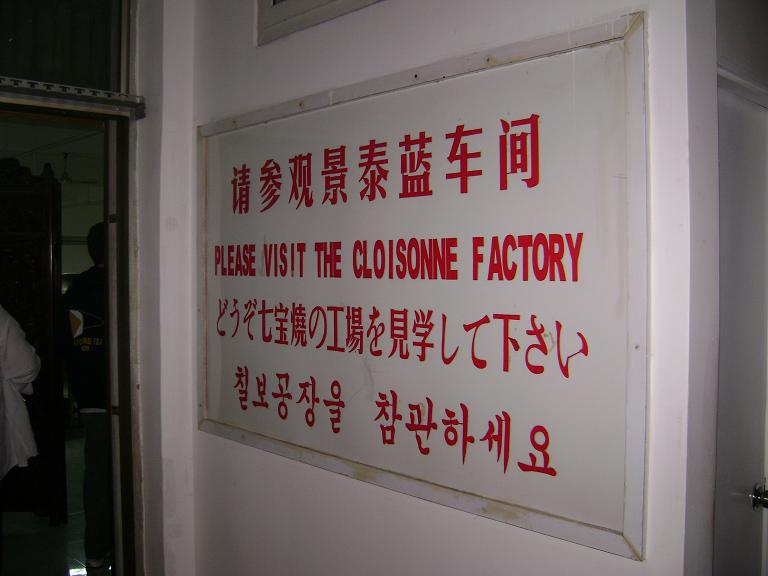
where we watched workers hand make the various cloisonne products available for purchase in the retail section of the building.
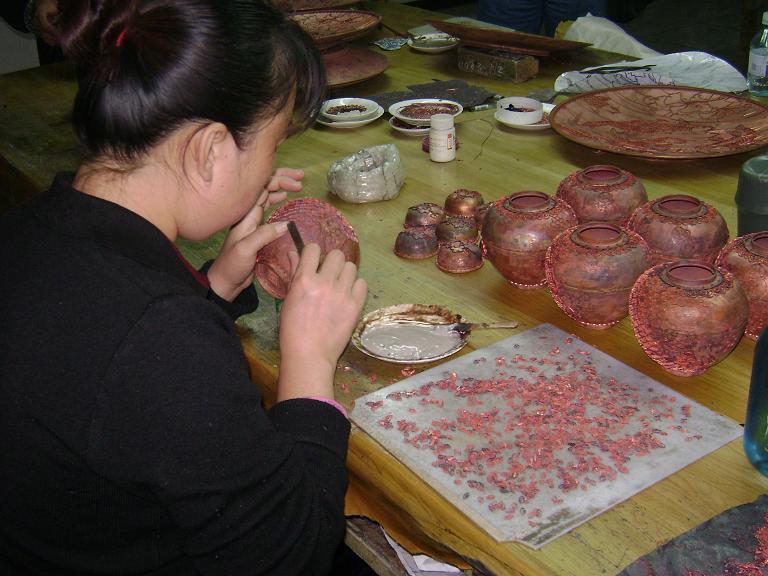
After the factory tour, but before shopping in the retail area, we had a very filling lunch in the restaurant, also on site here. Our delegation of 20 sat around two large round tables, with a lazy Susan in the middle, and a family-style lunch ensued, with the following menu:
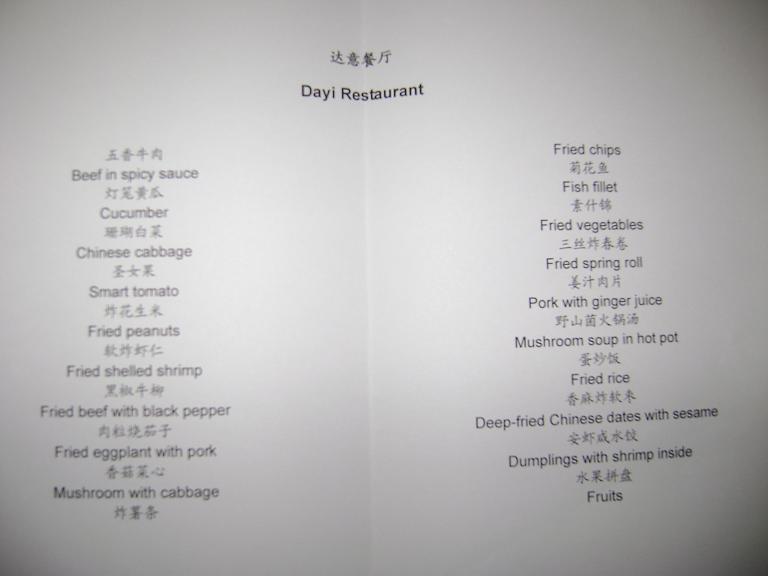
After an hour’s worth of shopping time, we boarded the bus and headed to our second, and final, stop of the day, the Great Wall of China. Here I am at the entrance:
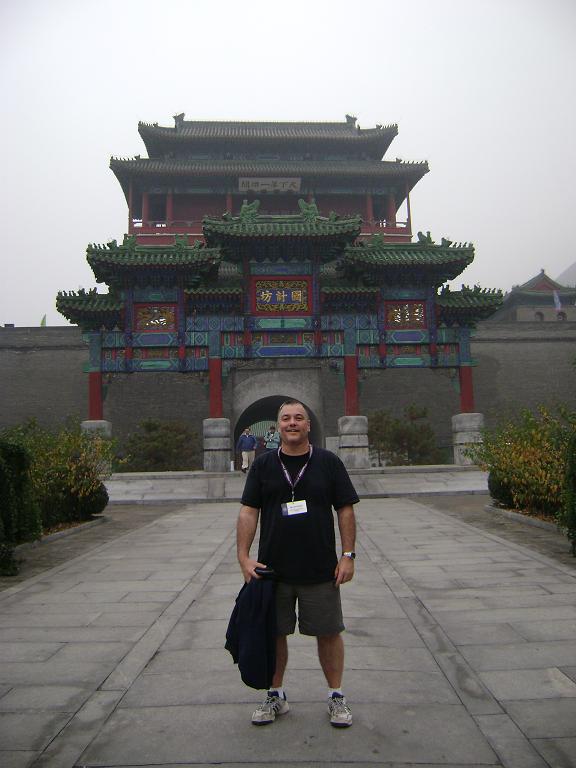
It was quite foggy (mixed with pollution) today, and this is about a good a distance picture of the wall that I was able to get:
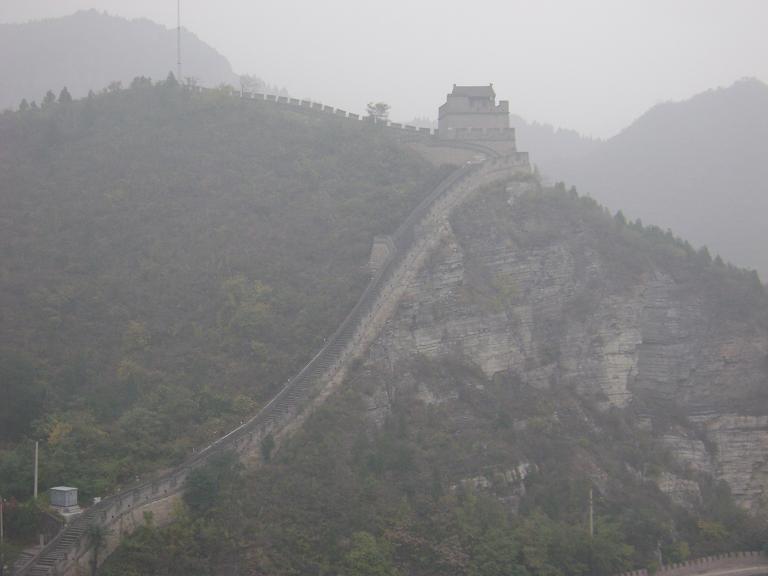
The steps were incredibly steep, and the path very long to get to the very top turrets, and only a few of our delegation did it. At one point, there was a young couple in front of me, the lady of which was in these totally non-sensible shoes for such an occasion was stopping every 10 or 15 steps, obviously struggling through the climb.
There were just a couple of picture-worthy signs along the way, my favorite of which was:
Coming down went much more smoothly, and quickly, than going up. Here’s a shot of the four members in our delegation with whom I walked down from the top with (along the wall from top to bottom): Debbie Davy, her son Konrad, Kirsten, and her mother Jeanne.
We left The Wall at 4:30, and as we got on our way, Shawn handed each of us a gift-a certificate stating that we had climbed The Great Wall, signed by himself and our delegation leader, Linda Oestreich.
We had about an hour ride back to the hotel, and upon arrival I think most of the delegation agreed to meet at 7:00 for dinner, which was on our own tonight. Shawng had recommended a very nice restaurant right behind our hotel, but I really wasn’t hungry (an absolute rarity, of which I decided to take advantage), so I bowed out for the evening.
Back in my room, I uploaded the day’s pictures and worked on my blog a little before taking a break and falling asleep for about an hour. When I woke up, I finished this blog entry, including re-sizing the photos for this entry, and then I rehearsed my presentation, which I’ll deliver tomorrow morning at our first professional visit. I’ll be very relieved when it’s done. Have I mentioned that I hate presenting?
I went to bed at about 1:30AM.